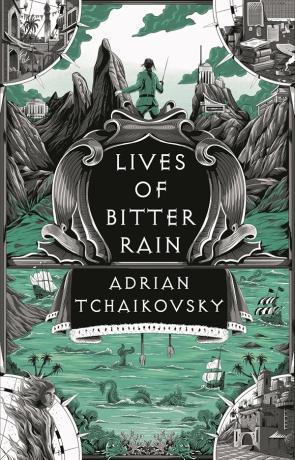Are Universes contained within Black Holes?

According to Nikodem Poplawski - physicist at the Indiana University in the US, our universe may actually sit inside a black hole that is in itself part of a larger universe. According to this new, quite outlandish and crazy sounding theory which has been published in the journal "Physics Letters B", a black hole is actually a tunnel between other universes and all the black holes in our universe could be doorways to alternative realities.
Poplawski's new mathamatical model describes the spiraling motion of matter falling into a black hole and could be a viable alternative to Einstein's "space-time singularities" that are proposed to inhabit the centre of black holes.
Einstein's theory suggests that when matter in a given reason becomes too dense (ie from the collapse of a star and creation of a black hole) singularities are created. This theory has long been seen as too difficult to accept by scientists as it means that these singularities take up no space, are infinitely dense and infinitely hot. This is supported by some indirect evidence but if would be disproved if Poplawski's theory was accepted.
In Popawski's model, matter that is drawn into a black hole gets thrown out at the other end and becomes the matter for building galaxies, solar systems and stars in this new universe. From the other side this would be seen as a "white hole", the polar opposite of black holes. This would also explain how our own universe was created, rather than the big bang creation theory, our universe would have been created by matter thrown out by one of these "white holes".
If proved correct, this new theory would also explain gamma rays bursts which are the second most powerful explosions after the big bang but have so far proved impossible to explain. They appear to be associated with the supernova of stars in far away galaxies but their actual source remains a mystery. These bursts could be discharges of matter from these alternate universes in Popaswski's model, escaping from supermassive black holes at the heart of galaxies.
If that wasn't enough the theory could even help explain "exotic matter" or why some features of the universe don't conform to expected predictions.
The idea that Black holes are "worm holes" to another universe / dimension / reality is not excatly a new one and has been suggested a number of times in the past.
There have even been films like the classic 1979 disney film "The Black Hole" which was novelised by Alan Dean Foster (rumoured to be in the process of being remade) and more recently the 1997 scifi horror film "Event horizon" which starred Sam Neill and Laurence Fishburne.
A number of books have also featured the Black hole worm hole theory from the fantastically named "young adult" novel "Stowaway to the Mushroom Planet" (written in 1956 by Eleanor Cameron) to Gregory Benford's 1990 novel "Beyond the fall of Night" which is itself based on Arthur C Clarke's 1956 science fiction novel "The City and the Stars" (which is itself based on the earlier novella "Against the Fall of Night").
There is only a very small possibility that this oulandish theory could ever be proved, which involves the premise that as some black holes rotate, if our galaxy is within a rotating version then we could somehow measure this rotation. It is more likely though that this will not be proved within the forseeable future.
News Archives
- August 2024
- July 2023
- April 2023
- February 2023
- September 2022
- March 2022
- February 2022
- July 2021
- June 2021
- April 2021
- March 2021
- January 2021
- October 2020
- September 2020
- June 2020
- March 2020
- May 2019
- January 2019
- November 2018
- January 2016
- September 2015
- August 2015
- July 2015
- June 2015
- May 2015
- April 2015
- March 2015
- January 2015
- October 2014
- June 2014
- April 2014
- March 2014
- February 2014
- January 2014
- December 2013
- November 2013
- October 2013
- September 2013
- June 2013
- May 2013
- April 2013
- March 2013
- January 2013
- December 2012
- November 2012
- August 2012
- July 2012
- June 2012
- May 2012
- April 2012
- March 2012
- February 2012
- January 2012
- December 2011
- November 2011
- October 2011
- September 2011
- August 2011
- July 2011
- June 2011
- May 2011
- April 2011
- March 2011
- February 2011
- January 2011
- December 2010
- November 2010
- October 2010
- September 2010
- August 2010
- July 2010
- June 2010
- May 2010
- April 2010
- March 2010
- February 2010
- January 2010
- December 2009
- November 2009
- October 2009
- September 2009
- August 2009
- July 2009
- June 2009
- May 2009
- April 2009
- March 2009
- February 2009
- January 2009
- December 2008
- November 2008
- October 2008
- September 2008
